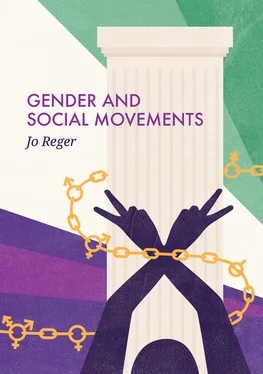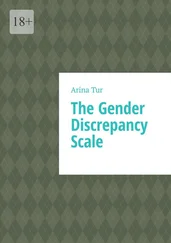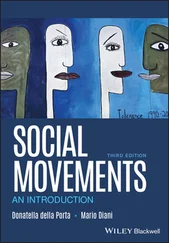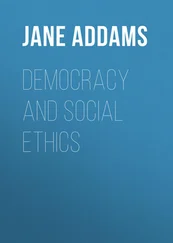Returning to the idea that gender is a structure as well as a process, we can see how gender is present in large-scale structures and processes, such as in institutions, organizations, societal norms, and ideologies. Joan Acker (1990) noted how gender is integral in the construction of organizations, shaping policy, practices, and infrastructure. While she notes that feminist sociologists have examined male dominance in leadership, hierarchy, and opportunities in organizations, missing is a sense of how gender is embedded in the documents and policies that construct the organization and become the groundwork for its belief system. She writes that “advantage and disadvantage, exploitation and control, action and emotion, meaning and identity, are patterned through and in terms of a distinction between male and female, masculine and feminine” (1990: 146). For example, considering gender as a structure includes understanding how it shapes the division of labor, wages, performance evaluations, and job descriptions within the workplace (Martin 2003; Ridgeway 2001). These differences are not due to innate differences between women and men but instead are the result of gender positioning people differently in the social structure (Lorber 1994).
Barbara Risman (2004) adds to our understanding by arguing that it is best to conceptualize gender as an overall structure that is found in the individual level (through processes such as socialization and the construction of selves), the interactional, cultural level (evident interactions around status, bias, and power), and the institutional domain (which accounts for organizational practices, legal regulations, resources, and ideology). This conceptualization captures the complex ways in which gender exists in society with multiple levels extending from the individual, sustained in interaction, and embedded in the ways the social structure, institutions, and organizations function. Drawing on this multi-level conception of gender allows us to see how the #MeToo movement is more than just the result of the actions of individuals but is also the result of gendered interactions that are supported within organizations and structured by gendered policy, norms, and regulations. For instance, Weinstein was able to escape any sanctions for his behavior due to the institutional order he was embedded in, the power he held over those lower on the hierarchy, and laws and policies that have limits in terms of enforcement. His behavior was also supported by a culture that accepted and encouraged his domination over women.
How gender binary sorts society is also illustrated in the Weinstein case. Much of the power and control evident in his assaults were derived from his status as the most powerful person – masculine, manly, male – in the room. The power and status he achieved outside the room were also a benefit of masculinity in society. In other words, Harvey Weinstein was not just a bad person, he was a person, because of the divisions of masculinity and femininity in society, who was able to dominate, control, and assault women. Overall, the gender binary divides all levels of gender from the individual to the societal. In many societies the gender binary is accepted because it aligns with Western thought’s use of dichotomies to understand the social world. Dichotomies divide the world into simple binaries, such as black and white, rich and poor, men and women, and in the process solidify one side’s power and value in society. Our cultural aversion to ambiguity makes it difficult to see past binaries and recognize that a more complex situation exists. Therefore, the gender binary structures and sorts our world, even when people identify as being outside of it.
In sum, acknowledging that gender is multi-dimensional and always in flux contributes to how we understand the social world around us and how it changes. Understanding gender as a form of power and control in society is also key in social change. Knowing that society is always changing also helps us to understand what social movements are and how they arise.
How Social Movements Change Society
We know that social change happens in a variety of ways and is sometimes unintentional – for example, shifts in societies occur when new economies, populations, and/or technologies are introduced. However, sometimes social change is intentionally sought and can be the result of social movements. Social movements are made up of individuals who come together in organizations, communities, and/or networks with the goal of making or resisting change happening in society (Tarrow 1998). What makes these “social movements” versus other efforts to change society is that they are in opposition to some segment of society. Aspects of society targeted by social movements include the powerful elites who control institutions and the rules, laws, or cultural norms that disadvantage a societal group. Some social movements challenge the state working to change laws or policies. For instance, movements on both sides of the abortion debate work to change the laws around access to abortion with a focus on the Supreme Court, as well as on state laws. Social movements also challenge cultural ideas and work to change social norms. For example, some participants in the women’s movement in the 1970s sought to change the language used to refer to women, arguing that calling women “girls,” “chicks,’’ or “foxes” was denigrating (Mallinson 2017). Overall, social movements are about changing the social order, which entails personal as well as collective change, and cultural as well as institutional transformation. For example, the lesbian, gay, bisexual, transgender, queer, and beyond movement (LGBTQ+) not only worked to change laws but also to change social norms around the acceptance and portrayal of LGBTQ+ people and worked to create a sense of pride versus marginalization in individuals. In either case – the focus on institutions or the focus on culture – the key to understanding social movements is that they are not spontaneous but are often the result of generations of organizing. Social movements are also not chaotic but instead have some sort of organizing structure, which can often vary depending on the beliefs and goals of the organization. As such, social movements can survive for long periods of time and engage multiple generations of activists (Reger 2012; Rupp and Taylor 1987; Taylor 1989; Whittier 1995).
To achieve their goals, social movements draw on a variety of actions called tactics. Those tactics can range from large-scale demonstrations such as marches on Washington, to the more individual such as legislative lobbying. Tactics can also be more symbolic and use everyday actions such as embracing an activist identity in daily life, through actions such as recycling or wearing a T-shirt connected to a movement. Movements often draw on more than one tactic, in what social movement scholars call a “tactical repertoire” (Taylor and Van Dyke 2004). Important in the creation of that repertoire is the overall strategy, or plan of action, embraced by the movement activists. For example, if the movement adopts the strategy of non-violence as the means to achieve their goals, the corresponding tactics would include those that endorse non-violent civil disobedience such as sit ins or street theater.
Strategy and tactics emerge from individuals’ interactions within the movement, along with the sense of being a united group sharing a set of common values and interests. Identified as a collective identity (Melucci 1989), this sense of belonging emerges from the construction of a sense of who “we” are as a group, as opposed to “them,” the opposition or target. This shared activist identity emerges from three processes: the development of a group consciousness with common values, beliefs, and goals, the delineation of boundaries between “us” and “them,” and the negotiation across those boundaries in pursuit of the overall goal (Taylor and Whittier 1992). The creation of collective, or activist identities, is essential in sustaining movements and directing the course of action.
Читать дальше












